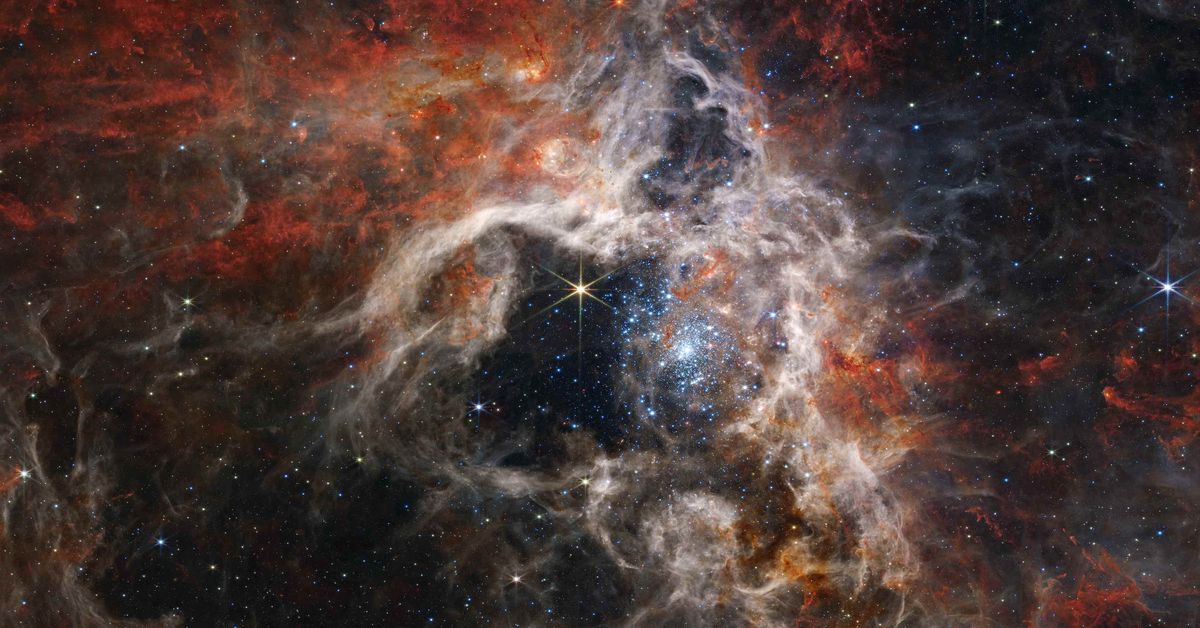When you check into a hotel room, what do you do? You immediately poke around. You scope out the outlets, pull back the curtain, open the closet, see what’s in the minibar, make sure there’s nothing gross in the bathroom. Only when you have a full sense of what’s around you do you sit down and think about unpacking.
We — as in those of us who exist as sentient corporeal beings in four dimensions — have yet to really do this with much effectiveness in the cosmos. But lord knows we’re trying.
On Dec. 25, 2021, NASA, with aid from the European and Canadian Space Agencies, launched the James Webb Space Telescope, the most high-tech piece of surveillance equipment in the galaxy (at least that we’re aware of). If there’s anything better, JWST will find it.
Hardcore NASA nerds, or at least those that visit r/spaceporn, are already well aware of the incredible hurdles it took to get JWST off the ground and sending back remarkable images. But for those that have been a little more earthbound, the new IMAX documentary Deep Sky is just the thing.
While the 40-minute film is already playing at nearly 30 North American planetariums, air and space museums, and science centers (plus two in Australia), Deep Sky is getting a full release at over 300 traditional theater IMAX locations for one week beginning April 19. (This is pegged to Earth Day, which is nice and all, but Deep Sky is actually the least Earth movie ever made. It’s about everything but Earth!)
The film, which rules, is directed by Nathaniel Kahn, who burst on the documentary scene in 2003 with My Architect, a clue-hunting biography about his father, Louis Kahn. From a structure and screenplay point of view, Kahn isn’t reinventing anything with Deep Sky. He’s got the talking-head interviews (tech dorks with varying degrees of media readiness), a celebrity narrator (in this case, Michelle Williams), and computer-simulated visualizations to use as a crutch (they’ve already been battle-tested by NASA, so they look good.) The ace up his sleeve? The enormity of this project itself, and the truly awe-inspiring images from JWST.
:no_upscale()/cdn.vox-cdn.com/uploads/chorus_asset/file/25356071/Phantom_Galaxy_across_the_spectrum_Webb_Hubble_ACS_MIRI_ESA.jpg)
Photo: ESA/Webb, NASA & CSA, J. Lee and the PHANGS-JWST Team; ESA/Hubble & NASA, R. Chandar
The story begins — as all stories do! — with the Big Bang. Williams’ dulcet tones offer a fine counterpoint to the chaotic origins of all existence (or, at least, all existence in this universe). We’re then reminded that the simple act of looking at the sky is also looking back in time. The light we see from a distant star isn’t shining now, it is shining then. And the deeper we look, the closer we get to the confounding birth of time and space itself.
This is basic middle school science, but when the eggheads that built JWST start talking about the implications of their work, it gets the blood moving. We will never know the answers to life, the universe, and everything unless we ask the questions as loudly as possible. And an enormous telescope outside of Earth’s atmosphere (outside of Earth’s orbit!) is a needed early step.
So you might think, Yeah, fly a telescope into space, how hard could that be? Rockets launch stuff into space all the time, right? When Kahn brings IMAX cameras into Northrop Grumman’s Redondo Beach, California, manufacturing facilities and you see its construction, you begin to recognize how complex this operation truly was.
Humans look puny next to the telescope, but it needs to do several Optimus Prime-like moves to fit onto a rocket’s delivery system. Then there’s the problem of keeping the equipment cool enough in the face of solar blasts, so a thin heat shield needs to get built. To me it looked thinner than the aluminum foil used to cover last night’s meatloaf, and, indeed, tears in this material are a frequent setback. It took about 14 years to build and cost — well, who cares what it cost? Northrup Grumman’s other gig, manufacturing weapons that kill civilians, cost a lot, too.
(Fun factoid: The lens on JWST was made by Ball, the same company behind the mason jars your grandmother uses for raspberry preserves. This organization’s two core businesses are engineering the most complex lenses for bleeding-edge space projects and making vessels for peach tea.)
After a trip through the Panama Canal and the French Guiana-based launch, Deep Sky introduces the terrifying concept of the “single-point failure.” To properly deploy JWST, there were a gobsmacking 344 highly detailed maneuvers it needed to make, and if just one of them did not go as planned, that was it. All that time, all that money, all those hopes and dreams would go straight down NASA’s zero-gravity toilet. I don’t know about you, but I can barely stream a movie off my friend’s Plex without at least one hiccup, but somehow the team pulled this off.
:no_upscale()/cdn.vox-cdn.com/uploads/chorus_asset/file/25356078/GettyImages_566015373.jpg)
Photo: Allen J. Schaben/Los Angeles Times via Getty Images
:no_upscale()/cdn.vox-cdn.com/uploads/chorus_asset/file/25356079/GettyImages_620500322.jpg)
Photo: Alex Wong/Getty Images
Once everything snaps into place, we wait — and Michelle Williams explains a little more about what to expect. In 1990, NASA launched the Hubble Space Telescope, which orbits Earth and has the same basic job as JWST: shoot pictures of the distant past. The images have delighted space nerds for decades (especially aging Pearl Jam fans), but Deep Sky does a solid job of showing how limited it is.
Time and again, we see JWST’s version of the same deep-space spots where Hubble once impressed us. One can’t help but shout “Hubble got cucked!” after the fifth example, or maybe that was just me. All I can say is that the new clarity and precision is remarkable when placed side by side.
Apart from just looking awesome, Deep Sky takes a detour to explain what these luscious images mean. The Tarantula Nebula offers insight into the birth of stars and Stephan’s Quintet shows how galaxies can merge with one another. (Something we may someday need to do here in the Milky Way, who knows?)
:no_upscale()/cdn.vox-cdn.com/uploads/chorus_asset/file/25356080/PILLARS_OF_CREATION_COMPOSITE_16bit_CB.jpg)
Photo: NASA, ESA, CSA, STScI, and Alyssa Pagan (STScI)
Naturally, exoplanet specialists are keen to find places that may be conducive to hosting life. (Or, at least, life as we understand it.) For a hot minute it looked like WASP-17 b over 1,300 light-years from us might have been the spot, but JWST has proven it not to be the case. No matter: With upward of a trillion galaxies, each with billions of stars, and each with several planets in orbit (and moons around those planets), something’s gonna be a match. And there are many who think it could be one of the seven planets orbiting TRAPPIST-1, which is a mere 40 light-years away. Deep Sky shows the team getting ready to do the full probe. Suddenly a conversation with another life-form doesn’t sound quite so crazy.
As a film, Deep Sky makes incredible use of IMAX. Anything with a combination of a rocket launch, gigantic scientific equipment, and detailed space porn imagery would, but Kahn’s smart use of emotional interviewees and cool music by Paul Leonard-Morgan puts it over the top. (Leonard-Morgan has been documentarian Errol Morris’ guy for several years, and also composed the score to the little-seen but pretty neat Amazon series Tales from the Loop.)
But my favorite part of Deep Sky has nothing to do with the overwhelming majesty of its format. In fact, it’s the only moment in the movie that looks like junk. In an unimpressive room somewhere in Maryland are a bunch of cubicles and standard-looking computers. There you’ll meet Joseph DePasquale, as wonderful of a random sample of humanity as ever there was. This blisteringly normal-seeming dude with a Jason Mantzoukas-like beard who maybe drives a Toyota Camry and gets a turkey sandwich and Diet Coke for lunch at the cafeteria was the first earthling to receive data from the James Webb Space Telescope. At first it was just a black square on his monitor. But with the right filter, more was revealed. And with the right understanding, it could lead to everything.
Deep Sky opens in IMAX theaters for one week starting April 19.









